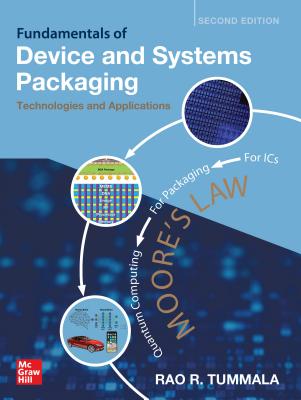MEMS/MOEM Packaging
暫譯: MEMS/MOEM 封裝
Ken Gilleo
- 出版商: McGraw-Hill Education
- 出版日期: 2005-08-01
- 售價: $6,630
- 貴賓價: 9.5 折 $6,299
- 語言: 英文
- 頁數: 240
- 裝訂: Hardcover
- ISBN: 0071455566
- ISBN-13: 9780071455565
海外代購書籍(需單獨結帳)
商品描述
While MEMS technology has progressed rapidly, commercialization of MEMS has been hindered by packaging technology barriers and costs. One of the key issues in the industrialization of MEMS, MOEM and ultimately Nanoelectrical devices is the development of appropriate packaging solutions for the protection, assembly, and long term reliable operation. This book rigorously examines the properties of the materials used in MEMS and MOEN assembly then evaluates them in terms of their routing, electrical performance, thermal management and reliability. With this as a starting point, the book moves on to discuss advanced packaging methods such as: molded thermoplastic packages for MEMS, wafer-assembled RFID, and wafer-level stacked packaging.
Table of Contents
PREFACE
Chapter 1: Engineering Fundamentals of MEMS and MOEMS Electronic Packaging
1.1: The Package as the Vital Bridge
1.2: Packaging Challenges
1.3: Multiple Functions
1.4: Package Types
1.5: Reliability and Qualification
1.6: SummaryChapter 2: Principles, Materials, and Fabrication of MEMS and MOEMS Devices
2.1: Definitions and Classifications
2.2: Basic Principles
2.3: Sensing
2.4: MEMS Sensor Principles
2.5: Motion Actuation
2.6: MEMS "Engines"
2.7: CAD Structure Library; Building Blocks
2.8: MEMS Devices
2.9: Optical-MEMS; MOEMS
2.10: Intelligent MEMS
2.11: MEMS Applications
2.12: MOEMS Devices -- MEMS Plus Light
2.13: SummaryChapter 3: MEMS and MOEMS Packaging Challenges and Strategies
3.1: Product-Specific Character of MEMS Packaging
3.2: MEMS General Packaging Requirements
3.3: Hermeticity: Levels, Evaluation Methods, and Requirements: Perceived vs. Actual
3.4: Cost versus Performance Tradeoffs
3.5: Emergence of Low-Cost Near-Hermetic Packaging
3.6: Manufacturing Process Comparisons
3.7: The Packaging MOEMS (Optical-MEMS) -- Additional Requirements
3.8: Packages for Materials Handling
3.9: NHP Beyond MEMSChapter 4: MEMS Packaging Processes
4.1: Release Step
4.2: Singulation: Sawing and Protection
4.3: Capping Approaches
4.4: Die Attach
4.5: Wire Bonding
4.6: Flip Chip Methods
4.7: Tape Automated Bonding (TAB)
4.8: Selective Underfill and Encapsulation
4.9: Lid Sealing
4.10: Antistiction Processes
4.11: In-Process Handling
4.12: Applying In-Package Additives
4.13: Equipment
4.14: Testing
4.15: Reliability
4.16: Selecting the Right MEMS/MOEMS Package and Materials
4.17: Conclusions and SummaryChapter 5: MEMS Packaging Materials
5.1: The Process Determines the Materials
5.2: Joining Materials
5.3: Assembly Issues and Material Solutions
5.4: In-Package Additives
5.5: ConclusionsChapter 6: From MEMS and MOEMS to Nano Technology
6.1: Definitions are Important
6.2: Combining Nano and MEMS
6.3: Packaging Nano
6.4: Summary, Conclusions and the FutureBibliography
Index
商品描述(中文翻譯)
描述
儘管MEMS技術迅速發展,但MEMS的商業化仍受到封裝技術障礙和成本的限制。MEMS、MOEMS及最終的納米電氣設備工業化中的一個關鍵問題是開發適當的封裝解決方案,以保護、組裝和長期可靠運行。本書嚴格檢視用於MEMS和MOEMS組裝的材料特性,然後根據其路由、電氣性能、熱管理和可靠性進行評估。以此為起點,本書接著討論先進的封裝方法,例如:MEMS的模塑熱塑性封裝、晶圓組裝的RFID和晶圓級堆疊封裝。
內容表
前言
第一章:MEMS和MOEMS電子封裝的工程基礎
1.1:封裝作為重要的橋樑
1.2:封裝挑戰
1.3:多重功能
1.4:封裝類型
1.5:可靠性和認證
1.6:總結
第二章:MEMS和MOEMS設備的原理、材料和製造
2.1:定義和分類
2.2:基本原理
2.3:感測
2.4:MEMS感測器原理
2.5:運動驅動
2.6:MEMS「引擎」
2.7:CAD結構庫;構建模塊
2.8:MEMS設備
2.9:光學MEMS;MOEMS
2.10:智能MEMS
2.11:MEMS應用
2.12:MOEMS設備 -- MEMS加光
2.13:總結
第三章:MEMS和MOEMS封裝挑戰與策略
3.1:MEMS封裝的產品特定特徵
3.2:MEMS一般封裝要求
3.3:密封性:等級、評估方法和要求:感知與實際
3.4:成本與性能的權衡
3.5:低成本近密封封裝的出現
3.6:製造過程比較
3.7:封裝MOEMS(光學MEMS) -- 額外要求
3.8:材料處理的封裝
3.9:超越MEMS的NHP
第四章:MEMS封裝過程
4.1:釋放步驟
4.2:分割:鋸切和保護
4.3:封蓋方法
4.4:晶片附著
4.5:線焊接
4.6:翻轉晶片方法
4.7:膠帶自動焊接(TAB)
4.8:選擇性填充和封裝
4.9:蓋子密封
4.10:抗粘附過程
4.11:過程中的處理
4.12:應用封裝內添加劑
4.13:設備
4.14:測試
4.15:可靠性
4.16:選擇合適的MEMS/MOEMS封裝和材料
4.17:結論和總結
第五章:MEMS封裝材料
5.1:過程決定材料
5.2:連接材料
5.3:組裝問題和材料解決方案
5.4:封裝內添加劑
5.5:結論
第六章:從MEMS和MOEMS到納米技術
6.1:定義很重要
6.2:結合納米和MEMS
6.3:納米封裝
6.4:總結、結論和未來
參考文獻
索引






























